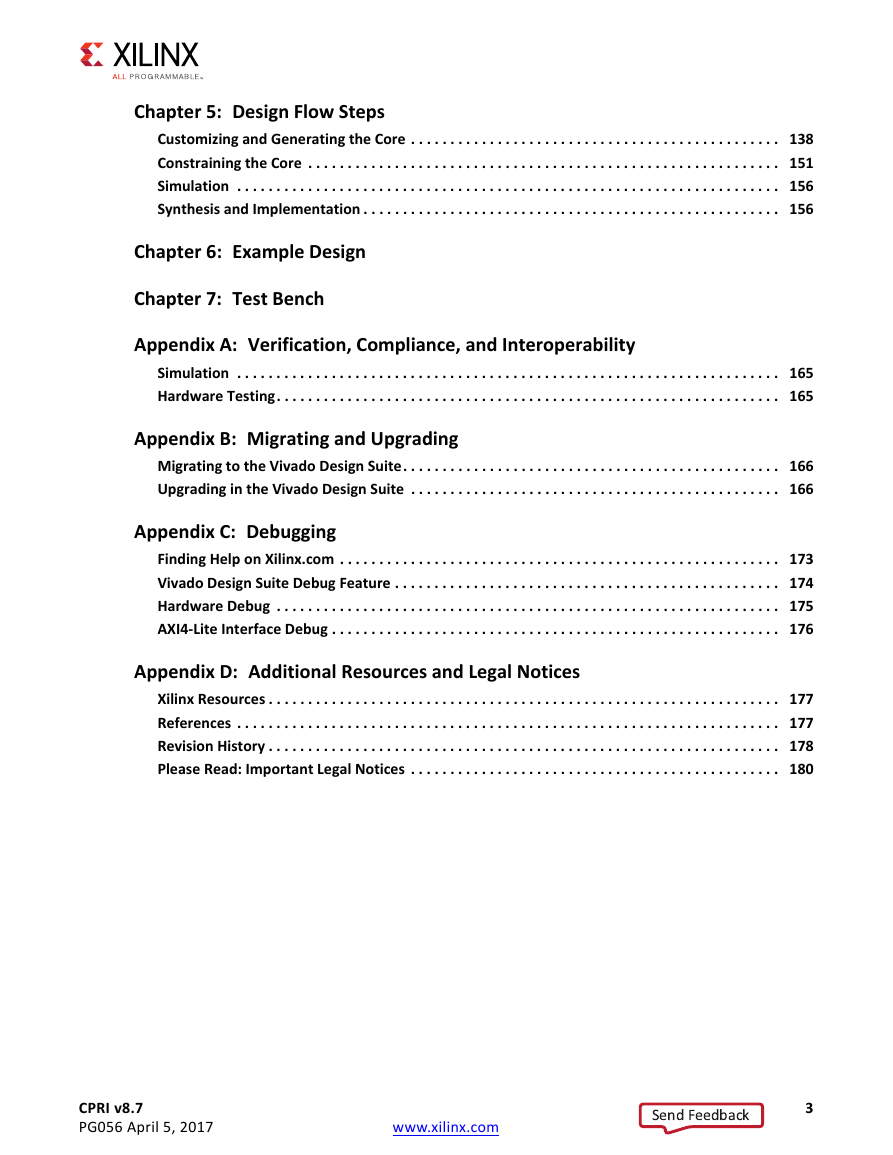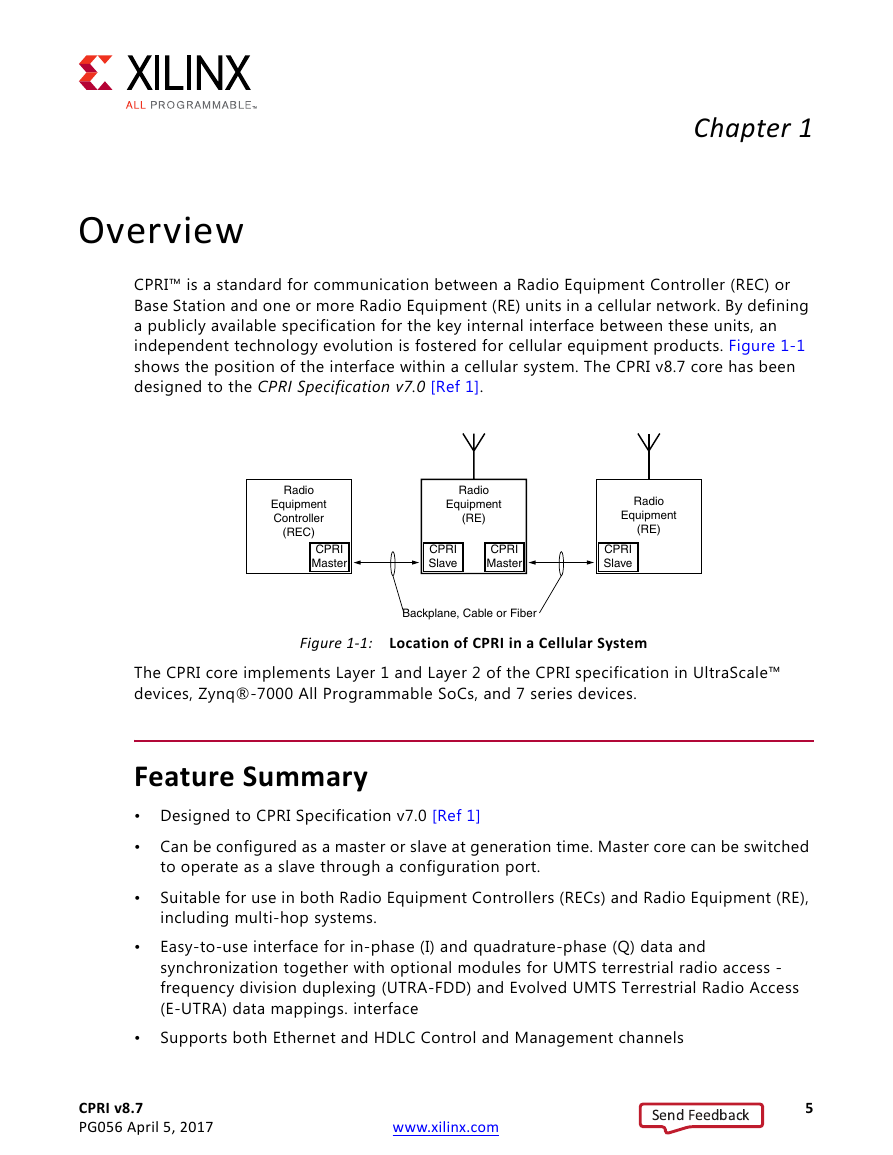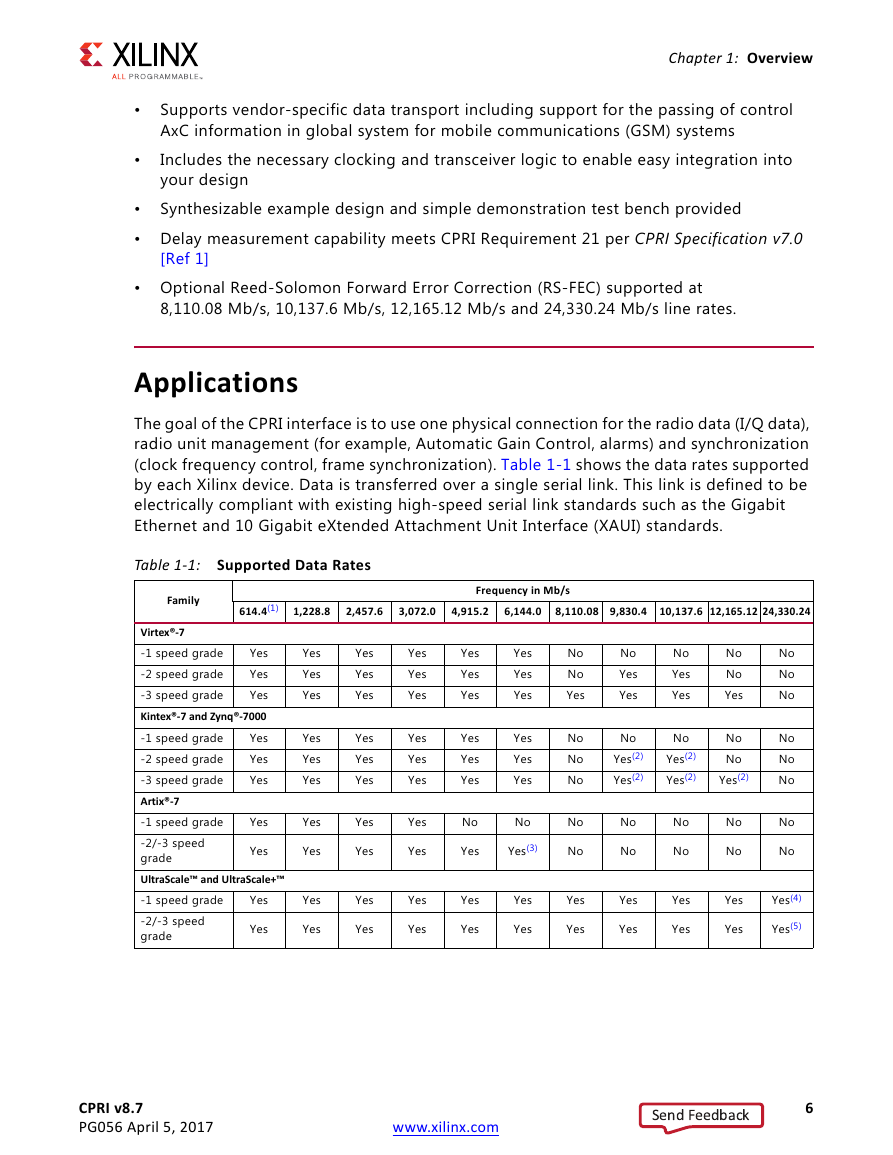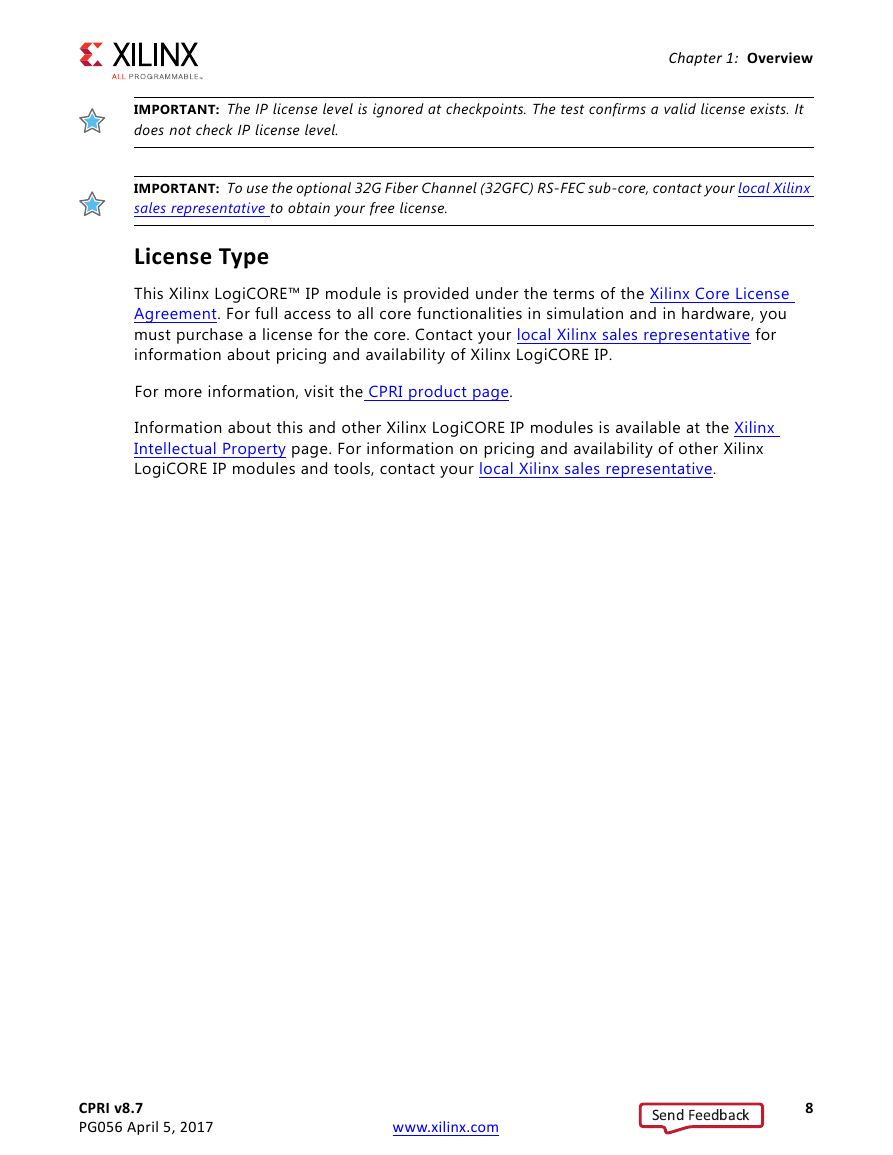CPRI v8.7
Table of Contents
IP Facts
Ch. 1: Overview
Feature Summary
Applications
System Requirements
Recommended Design Experience
Licensing and Ordering Information
License Checkers
License Type
Ch. 2: Product Specification
Chip Period (TC) in This Document
Related Information
Performance
Maximum Frequencies
Resource Utilization
Speed Grade Support
CPRI Core Structure
Port Descriptions
Management Register Map
Status Code and Alarm Register (0x0)
Miscellaneous Status Register (0x1)
Current HDLC Rate Register (0x2)
Current Ethernet Pointer Register (0x3)
Received Subchannel 2, Word 0 Register (0x4)
Received Subchannel 2, Word 1 Register (0x5)
Received Subchannel 2, Word 2 Register (0x6)
Received Subchannel 2, Word 3 Register (0x7)
Transceiver Loopback and Ethernet Reset Request Register (0x8)
Transceiver Barrel Shift Position Register(0x9)
Preferred HDLC Rate Register (0xA)
Preferred Ethernet Pointer Register (0xB)
Current Line Speed Register (0xC)
Line Speed Capability Register (0xD)
General Configuration and Transmit CPRI Alarms Register (0xE)
R21 Timers Register (0xF)
Current Protocol Version Register (0x10)
Preferred Protocol Version Register (0x11)
Scrambler Seed Register (0x12)
Descrambler Seed Register (0x13)
Transmit FIFO Transit Time Register (0x14)
Watchdog Timeout Value Register (0x15)
Gearbox Latency Register (0x16)
FIFO Fill Level Register (0x17)
General Debug Register (0x18)
High Resolution FIFO Transit Time—Integer Part Register (0x19)
High Resolution FIFO Transit Time—Fractional Part Register (0x1A)
FEC Status Register (0x1B)
FEC CW Count Register (0x1C)
FEC Corrected CW Count Register (0x1D)
FEC Uncorrected CW Count Register (0x1E)
Ch. 3: Designing with the Core
General Design Guidelines
Use the Example Design as a Starting Point
Know the Degree of Difficulty
Keep It Registered
Recognize Timing Critical Signals
Use Supported Design Flows
Make Only Allowed Modifications
Clocking and Resets
Interfacing to the Core
Data Interfaces
I/Q Interface
UTRA-FDD I/Q Module
E-UTRA I/Q Module
Legacy Raw I/Q Module
Vendor-Specific Data Interface
Real Time Vendor-Specific Support
Frame and Synchronization Interface
HDLC Interface
Ethernet Interface
MII Interface
GMII Interface
Bandwidth Timing on the MII Interface
Connecting the CPRI core to an Ethernet MAC on the FPGA
Interface with Ethernet Frame Buffers Bypassed
ORI Module
Serial Interface
Transceiver Interface
Transceiver Debug Interface
Transceiver Data Monitor Interface
Management Interface
AXI4-Lite Memory Mapped Interface
Status and Alarm Interfaces
Static Configuration Interface
Dynamic Configuration Interface
Ch. 4: Design Considerations
Reference Clock Selection
Clock Configuration
Virtex-7, Zynq-7000, and Kintex-7 Devices
Supporting Line Rates up to 3,072.0 Mb/s
Supporting Line Rates up to 6,144.0 Mb/s
Supporting Line Rates up to 9,830.4 Mb/s
Supporting Line Rates up to 10,137.6 Mb/s
Supporting Line Rates up to 12,165.12 Mb/s
Artix-7 Devices
Supporting Line Rates up to 3,072.0 Mb/s
Supporting Line Rates up to 6,144.0 Mb/s
UltraScale Architecture Devices
Supporting Line Rates up to 3,072.0 Mb/s and 6,144 Mb/s
Supporting Line Rates up to 9,830.4 Mb/s
Supporting Line Rates up to 10,137.6 Mb/s and 12,165.12 Mb/s
Supporting Line Rates up to 24,330.24 Mb/s
UltraScale GTYE3-based Devices (368.64 MHz Reference Clock)
UltraScale GTYE3-based and UltraScale+ GTYE4-based Devices (245.76 MHz Reference Clock)
Free Running Receiver Reference Clock (Artix-7 Only)
Using the PLL to Generate the Core Clock
Resource Sharing
Transmitter Clock Sharing
Transceiver Common Block Sharing
Core Support Layer
_clocking.vhd
_tx_alignment.vhd
_gt_common.vhd
_resets.vhd
Line Speed Configuration and Negotiation
Single Speed Operation
Multi-speed Operation with Rate Negotiation
Disabling the Core
RS-FEC Enabled Mode
Using an External GMII Interface
Delay Measurement and Requirement 21 (R21)
Delay Model
Delay Through the GTXE2 Transceiver
Delay Through the GTHE2 Transceiver
Delay Through the GTPE2 Transceiver
Delay Through the GTHE3 Transceiver
Delay Through the GTYE3 Transceiver
Delay Across the CDC FIFO
Overall Delay
Core I/Q Interface
UTRA-FDD I/Q Module
R21 Calculation
Coarse Delay Measurement
Additional Pipeline Delays
Cores Supporting 3,072.0 Mb/s
Cores Supporting 4,915.2/6,144.0 Mb/s
Cores Supporting 9,830.4 Mb/s
Cores Supporting 10,137.6 Mb/s
Cores Supporting 12,165.12 Mb/s and Above
Cores supporting FEC Enabled Mode
Performing the Cable Delay Calculation
Calculating T14 (CPRI Master)
Calculating Toffset (CPRI Slave)
Calculating the Cable Delay
Example R21 Delay Calculation
R21A Calculation
R19 Calculation
Ch. 5: Design Flow Steps
Customizing and Generating the Core
Component Name
Master/Slave
Speed and Reference Clock Selection
Use 32-bit Datapath
Use 64-bit Datapath
Free Running Receive Clock
Management Clock Rate
Transceiver Settings
Transceiver Location
Reference Clock Location
GT Type
Additional Transceiver Control and Status Ports
Optional Features
Include R21 Timers
AXI4-Lite Management Interface
ORI Support
Include Ethernet Logic
Use GMII Interface
Bypass Ethernet FIFOs
Real Time Vendor-Specific Support
Line Rate Support
FEC Enabled Mode
Shared Logic
Advanced
User Parameters
Output Generation
Constraining the Core
Required Constraints
Device, Package, and Speed Grade Selections
Clock Frequencies and Clock Management
System Clock Domain
Recovered Clock Domain
Management Clock Domain
Reset Block Clock Domain
Ethernet Clock Domain
Hi-Speed Clock Domain
Clock Placement
Banking
Transceiver Placement
I/O Standard and Placement
Simulation
Synthesis and Implementation
Ch. 6: Example Design
Ch. 7: Test Bench
Appx. A: Verification, Compliance, and Interoperability
Simulation
Hardware Testing
Appx. B: Migrating and Upgrading
Migrating to the Vivado Design Suite
Upgrading in the Vivado Design Suite
Device Migration
Port Changes in Version 8.7
Port Changes in Version 8.6
Port Changes in Version 8.5
Port Changes in Version 8.4
Ports Added in Version 8.3
Ports Added in Version 8.2
Ports Added in Version 8.1
Ports Added in Version 8.0
Changed Ports in Version 8.0
Appx. C: Debugging
Finding Help on Xilinx.com
Documentation
Answer Records
Technical Support
Vivado Design Suite Debug Feature
Hardware Debug
Hardware Demonstration Design
General Checks
CPRI Specific Checks
AXI4-Lite Interface Debug
Appx. D: Additional Resources and Legal Notices
Xilinx Resources
References
Revision History
Please Read: Important Legal Notices
















 2023年江西萍乡中考道德与法治真题及答案.doc
2023年江西萍乡中考道德与法治真题及答案.doc 2012年重庆南川中考生物真题及答案.doc
2012年重庆南川中考生物真题及答案.doc 2013年江西师范大学地理学综合及文艺理论基础考研真题.doc
2013年江西师范大学地理学综合及文艺理论基础考研真题.doc 2020年四川甘孜小升初语文真题及答案I卷.doc
2020年四川甘孜小升初语文真题及答案I卷.doc 2020年注册岩土工程师专业基础考试真题及答案.doc
2020年注册岩土工程师专业基础考试真题及答案.doc 2023-2024学年福建省厦门市九年级上学期数学月考试题及答案.doc
2023-2024学年福建省厦门市九年级上学期数学月考试题及答案.doc 2021-2022学年辽宁省沈阳市大东区九年级上学期语文期末试题及答案.doc
2021-2022学年辽宁省沈阳市大东区九年级上学期语文期末试题及答案.doc 2022-2023学年北京东城区初三第一学期物理期末试卷及答案.doc
2022-2023学年北京东城区初三第一学期物理期末试卷及答案.doc 2018上半年江西教师资格初中地理学科知识与教学能力真题及答案.doc
2018上半年江西教师资格初中地理学科知识与教学能力真题及答案.doc 2012年河北国家公务员申论考试真题及答案-省级.doc
2012年河北国家公务员申论考试真题及答案-省级.doc 2020-2021学年江苏省扬州市江都区邵樊片九年级上学期数学第一次质量检测试题及答案.doc
2020-2021学年江苏省扬州市江都区邵樊片九年级上学期数学第一次质量检测试题及答案.doc 2022下半年黑龙江教师资格证中学综合素质真题及答案.doc
2022下半年黑龙江教师资格证中学综合素质真题及答案.doc